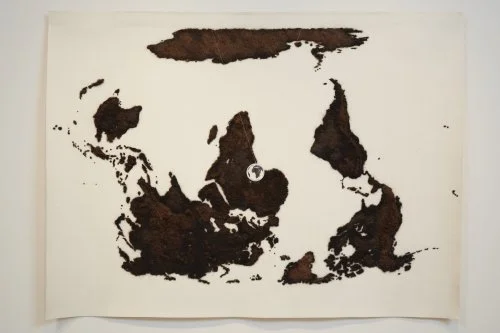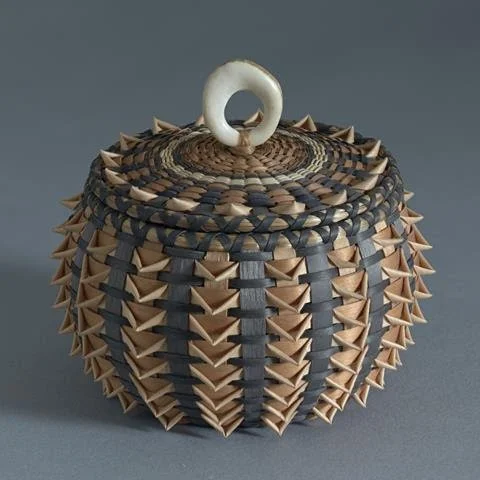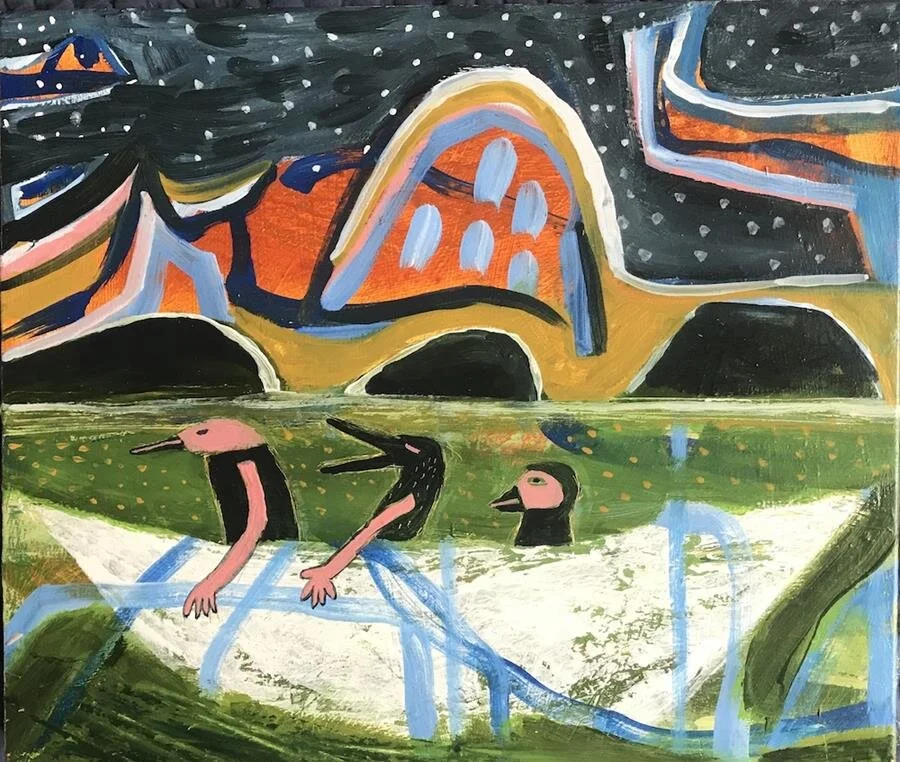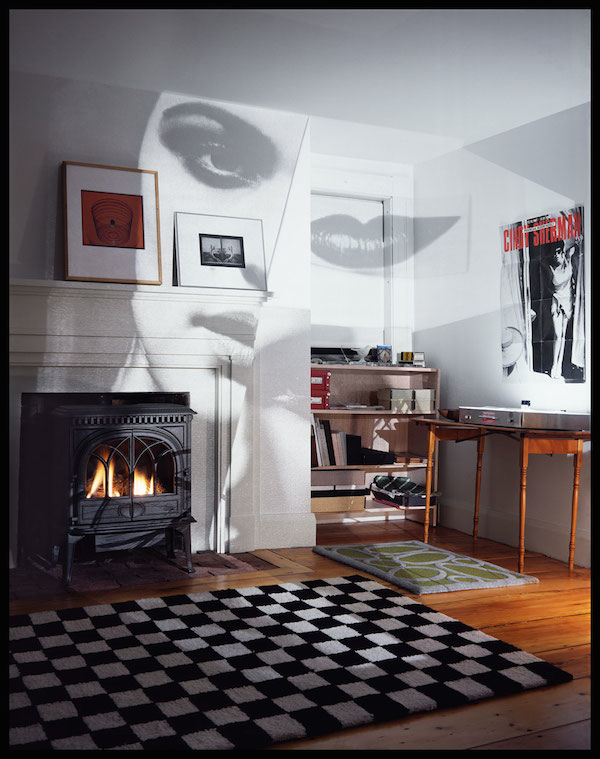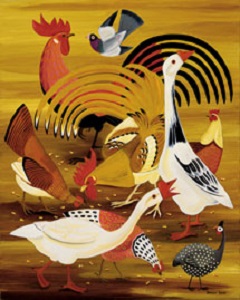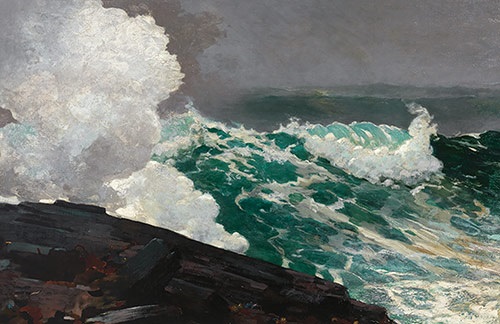
Will hold us to spring
“Super Bloom (clay, glaze), by Kathy Butterly, in her show “Out of One, Many/Headscapes,’’ at the Portland (Maine) Museum of Art.
©Kathy Butterly. Image courtesy the artist and James Cohan, New York. Photo: Alan Wiener.
The museum says that the show is an exhibition of small ceramic works. “These delicate, small-scale pieces …belie their size in meaning and complexity. This exhibit pulls together art from two bodies of work — ‘Out of One, Many,’ which ‘showcases the anthropomorphic, playful, intricate and provocative side of Butterly, and ‘Headscapes,’ which displays 10 pieces made specifically for this show.’’
Reminder
”Global Inversion” (wool felt, human hair and acrylic hair), by Diane Jacobs (America and Jewish), at the Portland (Maine) Museum of Art.
Antler art
Basket by Maine artist Sarah Sockbeson at the Portland Museum of Art.
The museum says:
Her work “offers insight into Wabanaki basketry as an ever-evolving art form. The incorporation of deer antler, which Sockbeson cuts, carves, and polishes herself, has emerged as a kind of signature—her personal inflection to a practice that both upholds and updates established techniques.’’
The Abenaki are an indigenous people of the Northern Woodlands of Canada and the United States. They are an Algonquian-speaking people and part of the Wabanaki Confederacy. The Eastern Abenaki language was predominantly spoken in Maine, while the Western Abenaki language was spoken in Quebec, Vermont and New Hampshire.
Dark green shows the territory of the Eastern Abenaki.
Everybody?
“All in this Together” (acrylic on panel), by Portland-based Anna Dibble, at the Portland Museum of Art, in its current show “Untitled, 2020, Art from Maine in a _______ Time’’ to open online on Feb. 12. Hit this link.
The museum says:
“The events of 2020 profoundly impacted artists in different ways. From personal hardships due to the COVID-19 pandemic, concerns around the election and political instability, and solidarity with a coalescing movement against systemic racism, {the show} records how artists working in Maine were coping with, and responding to, this pivotal moment in history.
But none the worse for it
"Black and Blue, '' by isamu Noguchi, in the show "Isamu Noguchi and the Borders of Sculpture,'' at the Portland Museum of Art, Oct. 5-Jan. 6.
The museum says the show:
"{I}nvestigates Noguchi’s expansive artistic practice by exploring his efforts to enlarge and challenge conventional notions of sculptural boundaries. Born in 1904, the Japanese-American modernist experimented endlessly with the intersection of objects, people, and space over the course of his 60-year career. Melding ideas and approaches to art from across the globe, Noguchi created traditional sculpture, landscape architecture, play structures, monuments, stage sets, interior designs, furniture, and more. This exhibition brings aspects of his varied production together, complicating notions of form and function and using the juxtaposition of materials, shapes, and techniques to encourage audiences to reimagine their sense of what sculpture can be.''
Drip art
"Drops of Rain' (detail, platinum print), by Clarence H. White, in the show "Clarence H. White and His World: The Art and Craft of Photography, 1895-1925,'' at the Portland Museum of Art.
The exhibition is the first in over 40 years to examine the work of White (1871⎻1925), a gifted photographer and founding member of the Photo⎻Secession. It aims to examine the scope of his artistic career, from its beginnings, in Newark, Ohio, to its end, in Mexico
The young kept busy in late 19th Century New England farm life
Right, "Young Farmers (Study for Weaning the Calf)'' (oil on canvas), painted in 1873-74, and, left, "Returning from the Spring'' (oil on panel), painted in 1874, both by Winslow Homer (1836-1910), at the Portland Museum of Art.
Winslow Homer (United States, 1836–1910), Young Farmers (Study for Weaning the Calf), 1873–74, oil on canvas, 13 5/8 x 11 1/2 inches.
Winslow Homer (United States, 1836 - 1910), Returning from the Spring, 1874, oil on panel, 7 7 /8 x 5 3/4 inches
Out to dry
Work by AARON T STEPHAN (no period after "T'') in his show "To Borrow, Cut, Copy, and Steal'', at the Portland Museum of Art, Sept. 6 to Feb. 8.
The museum says he'll present "four sculptural installations and a small selection of works on paper that convey his wit and his cheeky dialogue with the conventions and procedures of the art world.''
Maine food can't be main course for most
The Portland Museum of Art and the Maine Organic Farmers and Gardeners Association are promoting such activities as a Sunday, May 18, program, from 2 p.m. to 5 p.m. called "Healthy Soil, Healthy Foods'' to pump up agriculture in the Pine Tree State. All well and good, just as long as Mainers do not think that they can survive on Maine food alone. Midwest, Southern and California agriculture will rule for many years to come.
The Winslow Homer Studio
Winslow Homer's paintings have long been some of the most beloved art associated with New England. Thus many will want to visit the Winslow Homer Studio, at Prouts Neck, Maine. The studio, owned by the Portland Museum of Maine, is where the artist lived from 1883 until his death, in 1910. The museum says the studio is meant to "celebrate the artist's life, to encourage scholarship on Homer, and to educate audiences to appreciate the artistic heritage of Winslow Homer and Maine.''
Not that Homer is always that cheery. Many of his images show nature to be menacing, as in the painting "Northeaster'' below.
Something to look forward to
"Redbud Tree in Bottomload,'' photo by ELIOT PORTER, at the Portland Museum of Art (but photo is copyrighted by Amon Carter Museum of American Art, Forth Worth) in the Portland Museum's show "American Vision: Photographs from the Collection of Owen and Anna Wells''.
Please comment via rwhitcomb51@gmail.com
Jan. 7, 2014
Cold morning today but far from the "polar vortex'' catastrophe that it's being made out to be by the news media because their denizens think that nothing much else is going on. Of course, lots of stuff is going on but it bores those reporters and editors who haven't yet been laid off in the ferment caused by the triumph of mostly ''free'' information on the Internet. And maybe the public doesn't care all that much either.
Most importantly, "polar vortex'' sounds like a horror-movie monster. Very sexy. More vortexes to come because global warming is screwing up the jet stream? Too early to say with scientific assurance.
It's all rather typical of January, the coldest month. But February is often the snowiest because warm wet air begins to edge north again, setting up conflict with the cold air. Great for creating Nor'easters! Arctic air and the Gulf Stream can be in explosive proximity.
As I walked the dog this morning I enjoyed the crunch of my feet on the thin layer of snow that had fallen overnight as the front swung through from Canada, bringing a snow squall or two. And the frozen trees were creaking. Too cold to be slippery! The problem in the coastal Northeast is the wind. It can make urban walking miserable. When I lived in the Upper Connecticut River Valley, the temperature could be much colder than in Boston, Providence, New York and Philadelphia but the comfort level much higher because there was much less wind and it was very, very dry. Sort of exhilarating -- bright and almost antiseptically clean.
Meanwhile, along the lines of ever-more "nurturing'' of children by parents and schools (at the ones I attended we were often called by our last names and there wasn't much open concern for our feelings), is the practice of clothing our dogs for winter walks, even outside of the Upper East Side of Manhattan. I must confess that my wife and I have adopted this habit. The dog, a rescue mutt from San Antonio (via "Alamo Rescue''), fought having a coat on at the start but has since accepted it -- especially when it's windy.
My most physically painful memories of winter are in the streets of big cities with the northwest wind squeezing between the high buildings.
When it's really, really cold, ice is so sticky that you don't even worry about driving up and down steep snow-covered hills. A few times I had to drive my drunken mother to a drying-up spa at a place called Beech Hill Farm, on top of a mountain in Dublin, N.H. -- the little town where Yankee magazine was, and is, put out and where Mark Twain spent some happy times. If it was the winter, I'd pray for very cold weather. Around freezing was the most insidious, with a thin layer of melting in the sun, then quick refreezing toward evening.
The dramatic freeze-thaw cycles in New England make skiing more, well, exciting here than on the dusty, dry "powder snow'' promoted by resorts in the Rockies. Skiing in the White and Green mountains is much more of a challenge to muscles and nerves than is skiing at, say, Taos.
Anyway, I long for late February, when sun-facing cars and rooms suddenly seem to start to warm up much faster as the sun gets stronger. Even on a very cold day last week, I found the stone on a southwest-facing wall remarkably warm. We really do need to do a lot more with passive solar heating.


